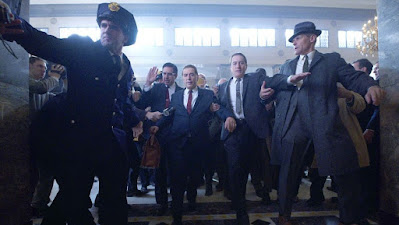Many have stated that Michael Bay is the Antichrist, and that he is emblematic of all that is wrong with Hollywood blockbuster filmmaking. His latest assault on the senses, 6 Underground (2019), is not likely to change many people’s negative opinions about his infamous reputation as the master of cinema as mass destruction. With that being said, 6 Underground is so deliriously over the top in its very Michael Bayish nature that there’s almost something fiendishly enjoyable about it.
But, really, 6 Underground is about Michael Bay spending Netflix’s millions of dollars so that he can go on a coke-fueled rampage with all his usual tools: one dimensional macho male characters who live in a world where all the women are lingerie super models, lots of shots of cool looking people standing in front of sports cars, scenes where characters do things that are so illogical that you wonder how they could figure out how to get out of bed in the morning...you get the point. And yet, despite the grating Michael Bayish nature of it all, you simply can’t take your eyes away from the insane mayhem on screen.
The opening car chase sequence is so viscerally exciting and well-staged that for a minute you might think you’re watching a vintage John Frankeinhemer action film. Bay literally throws every car chase cliche in the book at you, and event comments on them in an almost satirical manner, such as when he slows the film down to have our protagonists purposefully narrowly avoid hitting a woman with a baby and a pair of puppies. Bay also shows civilians getting mowed down all over the place, which is in contrast to Hollywood’s usual convention of car chases where miraculously no pedestrians are hit.
For a moment, you almost think Bay is making a film that is a deconstruction of Hollywood studio action film cliches, and then he’ll cut to a close-up shot of a woman’s rear end in a short skirt, and you remember that you’re still seeing a Michael Bay film. That is not to say that the other action set pieces in 6 Underground don’t live up to the opening sequence, because they surprisingly do. I don’t want to give away too much, but Bay stages an escape from a skyscraper in a manner that you have not seen before, and ends the film with a sequence involving a magnetized yacht that is almost surreal in its bonkers nature.
The best way to describe 6 Underground would be to call it an R-rated Looney Tunes cartoon. The frenzied and gravity defying action scenes almost recall the vibrant creativity of Frank Tashlin films like Son of Paleface and Who’s Minding The Store? However you want to define it as, an integral aspect of cinema is about the illusion of movement, from August and Louis Lumiere’s 1896 silent film The Arrival of a Train, which caused audiences to jump out of their seats because they thought the moving train on screen was real, to the frenetic action films of John Woo. I’m not saying Bay is as innovative as the Lumiere brothers or John Woo, but he is a highly skilled practitioner of depicting action film mayhem and destruction, and that is something that not everyone can execute successfully.
So, in summary, the question remains— is 6 Underground a good film? It all depends on how you define good. If you define good as being a film that is complex thematically and deals with deep philosophical issues, then 6 Underground is embarrassing. If you define good as a film that is entertaining and which knows how to keep the viewer involved in its elaborate action set pieces, then 6 Underground might be even better than good.
You can say what you will about Michael Bay being the most destructive force of nature to arrive on our planet since the invention of stinky tofu (which I personally like), but you can’t say that Michael Bay isn’t consistent in the very Michael Bayishness of his films. With 6 Underground, it feels like Michael Bay is taking all the criticism that has been thrown at him throughout his career, and purposefully amplifying it on a whole other level of Bayhem. Bay seems to live in a world that most of us don’t see, and that world may even be Hell, but at least he’s doing what he loves.































